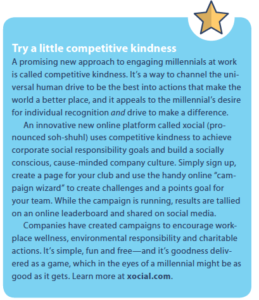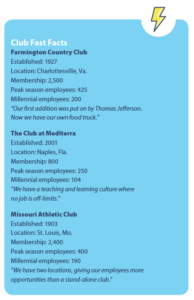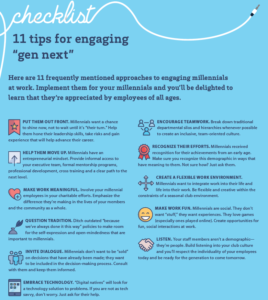First they were coming. Now they’re here—millennials are the largest cohort in U.S. workplaces and apparently the least engaged generation of your workforce. So what’s a club to do? When it comes to making work matter to millennials, it’s time to move from stereotypes to strategies—and three private clubs show you how.
We’ve all heard, read and maybe even verbalized the stereotypes about millennials. Raised on a steady diet of computer screens, video games and participation medals by helicopter parents, they’ve been labelled entitled, disloyal, immature, unfocused and socially inept. No wonder millennials themselves hate the term—it puts them in a pretty unflattering box.
Joe Krenn, CCM, chief operating officer and general manager of Farmington Country Club in Charlottesville, Va., isn’t a fan of the label. That’s because he is a millennial. (Or a Gen Xer, depending on whom you talk to, he says.)
“I don’t use the word ‘millennial’,” Krenn says. “I’d rather talk about the ‘next generation.’ Because there always will be one. And you have to be ready for it.”
So what is this next generation looking for in employment at your club? And how can you ensure they find it?
Why does it matter?
Millennials matter because they’re not only the future of your workforce, they’re in large proportion its present—and they aren’t particularly happy employees.
Millennials are the largest generation in U.S. history. They make up the largest share of America’s labor market today and, according to U.S. Bureau of Labor statistics, will account for almost half of U.S. employees by 2025. (More generous estimates predict that 75 percent of the U.S. workforce will be millennials by 2025.)
A recent Gallup report, How Millennials Want to Work and Live, tells us that only 29 percent of millennials are engaged at work. A staggering 60 percent say they’re open to different job opportunities. And one in two predict they’ll have moved on from their current employer a year from now.
It would be easy to shrug our collective shoulders and say, “well we knew they weren’t loyal anyway—guess we’d better bump up our recruitment budget.”
The Deloitte Millennial Survey 2017 indicates that national and global uncertainty may be tempering the job-hopping tendency to a small degree, particularly in the U.S., where millennials are more likely to say they’ll stay at their current employer longer than five years than say they’re leaving within two years—a significant change from 2016.
As Gallup explains, engagement is the key to millennial loyalty. Millennials who are engaged at work are 26 percent less likely to think about switching jobs for a pay hike of 20 percent or less, says Gallup. They’re also 64 percent less likely than actively disengaged millennials to say they’ll change employers if the job market improves.
Who are the millennials?
There’s no consensus on the specific birth years the millennial generation. Pew Research defines millennials as those born from 1981 to 1997. Gallup says they’re born between 1980 and 1996. In her winter 2015 article for Club Director, generational guru Sarah Sladek set the start at 1982 and the cut-off at 1995. The National Club Association uses the span from 1980 to 1999—meaning that the youngest millennial will be voting age this year, and the oldest will celebrate his or her 37th birthday.
Wally Smith, chief operating officer and general manager of the Missouri Athletic Club (MAC) in St. Louis, wanted to be sure how old millennials were—so he typed “age of millennials” into his phone.
“I got an instant answer,” Smith says. “That’s what defines millennials, I think. When I was growing up, if I wanted to learn something I went to the library or watched one of three TV stations. They’ve got the world at their fingertips.”
How do clubs engage this globally minded, ever-connected generation of employees?
Embracing technology is a good place to start. Millennials are the first generation to enter the workforce with a better understanding of technology than their bosses have. In a 2016 Microsoft survey, 93 percent of millennials said the latest technology was an important factor when choosing their employer. Seventy-three percent of millennials in a Price Waterhouse Coopers study said access to their preferred technology makes them more effective at work. As an interesting aside, Facebook’s research shows millennials check their phones an average of 157 times a day. “They’re not so much tech savvy as tech dependent,” says Krenn.
 Loyalty comes easier to millennials whose leadership skills are being developed. “They’re on a faster track to get to their career goal than an older generation,” says Shirlene Industrious, director of human resources at The Club at Mediterra in Naples, Fla. “They want that management position quickly.” Research shows that if they don’t get the leadership opportunities that support that goal, they’ll leave. Deloitte’s 2016 Millennial Survey reports that almost three-quarters (71%) of those who plan to leave their current employer in the next two years say they’re unhappy with how their leadership skills are being developed.
Loyalty comes easier to millennials whose leadership skills are being developed. “They’re on a faster track to get to their career goal than an older generation,” says Shirlene Industrious, director of human resources at The Club at Mediterra in Naples, Fla. “They want that management position quickly.” Research shows that if they don’t get the leadership opportunities that support that goal, they’ll leave. Deloitte’s 2016 Millennial Survey reports that almost three-quarters (71%) of those who plan to leave their current employer in the next two years say they’re unhappy with how their leadership skills are being developed.
Corporate social responsibility is also important to millennials. The 2016 Millennial Employee Engagement Study by Cone Communications indicates that almost two-thirds (64%) of millennials won’t work for a company that doesn’t have strong corporate social responsibility commitments. Three-quarters would work for a more responsible company, even if it meant a pay cut. In comparison, around half of all U.S. employees factor corporate social responsibility into their employment decisions. “Millennials want to be part of something bigger,” says Allyn Gutauskas, human resource manager at Farmington Country Club. “We get them involved with the different organizations we support.”
Gamification and team-building activities are popular among millennials, who are looking for interesting workplace experiences and opportunities to get to know their co-workers in a fun way. A poll by The Go Game, a San Francisco-based team-building business, showed that 79 percent of millennials felt that team and culture-building activities helped retain talent, compared to 46 percent of baby boomers. The online platform xocial (see sidebar above), which gamifies good deeds, is achieving its highest uptake from organizations that want to engage millennials.
“Younger employees want unique experiences and to have fun,” says Christine Maurer, director of human resources for the Missouri Athletic Club. “We hold contests, challenges and other competitions. Last fall we tried bubble soccer, and it was a great success with the under-35s.” Wally Smith agrees. “Engaging these guys to have fun is one of the key ways to make things work. If our guys aren’t having fun, our members won’t either.”
No club has to do everything at once. In fact, each of the clubs featured herein has chosen to identify one or two high-level strategies to better engage their millennial employees. When implemented, these strategies end up touching on many elements that make a workplace great for younger employees.
Farmington Country Club: Rewrite the rulebook
Tradition and propriety may be hallmarks of private clubs, but times change—and Farmington Country Club has made a special effort to examine its policies to gauge their relevance to the next generation.
“Our employee appearance standard used to say no visible tattoos,” says Krenn. “We were having a hard time filling steward and cook positions because of that policy and I said, ‘Name one member who doesn’t have at least one person in their family with a visible tattoo.’” Gutauskas agrees. “We had a millennial doing some research on this for us. Turns out 36 percent of millennials have at least one tattoo. We have to keep re-evaluating so we can be a good workplace for everybody.”
Farmington embarked on a club-wide examination of its cultural standards, including hair length and piercings as well as tattoos. The club’s employee appearance standards now stress “professionally reasonable” rather than outright prohibition. “There’s been no uprising from the membership because a server has a unicorn on her wrist,” Krenn says.
No policy is off-limits. Farmington has reworked its scheduling policy to add more flexibility (something millennials value) and rewritten its cell phone policy (which, in its original form, would’ve meant the club had fewer members, not just staff).
“You have to stay strategic and have a workplace culture that will get you to where you want to go,” says Gutauskas. “At the same time you have to maintain standards for your members.”
Consistent treatment, whether someone is a member or employee, is important to the club. “You need to put the same emphasis on employee culture as you do member culture,” says Krenn. “We weigh any decision we make against the three Rs—recruitment, relevance and retention. In the past we did that only for members. Now we apply the three Rs to our workforce, too.”
Clubs should visit the employee handbook on an ongoing basis, Allyn says. “After millennials there will be another generation. We now have a process in place to keep looking at these things.”
Missouri Athletic Club (MAC): Let them lead
They’re young. They’re inexperienced. They haven’t paid their dues. But rather than hide their millennial employees behind the scenes, the MAC gives them leadership roles and, in the words of Smith, “cuts them loose.”
The communications department is run by millennials, who are very active on social media and in tune with the importance of video in reaching new audiences. The associates council, which includes members and employees, is led by a millennial. The membership role, which is involved with the MAC’s board of directors, is filled by a millennial. From parade floats to charity fundraisers, the club encourages its younger employees to take the lead.
“I’m not telling our employees what to do,” Smith says. “I’m telling them to help us make this work within the bigger picture of what we’re trying to accomplish. I’ll say, ‘Come see me when you need some guidance. Have some fun. Make sure everybody knows you were there.’ They love that.”
Letting millennials take the reins, especially in the area of technology, solves problems for the club as well as creating meaningful work experiences for employees. Staff in the food and beverage department at the MAC’s West location now use a scheduling app as a communication tool, thanks to a millennial employee who was tired of calling coworkers to switch shifts.
“They’re the source of the solution,” Smith says. “Communication has improved in a big way and they’re the ones that brought it to the table. It’s challenging without young people to stay in front of what’s next.”
The Club at Mediterra: Invest in their future
If your millennial employee may leave you anyway—whether it’s because you don’t have that next professional opportunity for them, or because their personal dreams are calling them to go elsewhere—why invest in their success?
For The Club at Mediterra, the answer is simple. Having a great team now means never holding someone back from future opportunities, and the club has created a teaching and learning culture to foster an employee’s ability to move up and, if necessary, move on.
“We aren’t saying ‘Come take our staff,’” laughs Industrious. “What we want is the employee to be successful. Their success only reinforces our culture.”

 At Mediterra, employees are introduced by the GM/COO to all the directors and encouraged to reach out if they’re interested in learning more about a particular area of club operations. That way, an employee in culinary can learn about marketing and vice versa. Coaching conversations happen 30, 60 and 90 days into the new job. Employees are asked to share their goals, and managers are expected to help map the path to goal achievement. There’s even an education fund to support professional development.
At Mediterra, employees are introduced by the GM/COO to all the directors and encouraged to reach out if they’re interested in learning more about a particular area of club operations. That way, an employee in culinary can learn about marketing and vice versa. Coaching conversations happen 30, 60 and 90 days into the new job. Employees are asked to share their goals, and managers are expected to help map the path to goal achievement. There’s even an education fund to support professional development.
These approaches are appealing to millennials, who want a wide range of experiences, contact with mentors, clear expectations, titles that reflect their advancement and the chance to take that next big job, even if it’s at another club.
To make this work, clubs need to walk their talk. “Creating a culture of teaching and training starts at the top,” Industrious says. “Everyone on your leadership team has to be on board.” That means being able to show examples of staff that have been promoted from within. Following through on promises for learning opportunities. Not missing the 30-, 60- and 90-day check-ins. Being willing to see newer employees move up faster than you did. And, setting realistic expectations—both for the club and the employee.
“We’re proud of all of them,” Industrious says. “The ones that grow to the top here and the ones that leave for opportunities elsewhere. It’s part of our legacy to be an employer that invests in its staff.”
A last word on labels
The clubs featured have a distinct commonality: a belief that it’s better to consider the individual rather than the generation. Programs, policies and procedures may be developed to meet and manage the expectations of a generational type, but it’s unwise to make your human resources approaches solely generation-driven.
“I never think of someone’s generation,” says Industrious. “You can have a baby boomer that’s just as tech savvy as a millennial. Be aware of what inspires and motivates the individuals on your team. There are similar behaviors, but we caution any leader against leading or managing only based on a generation.”
Try a little competitive kindness
A promising new approach to engaging millennials at work is called competitive kindness. It’s a way to channel the universal human drive to be the best into actions that make the world a better place, and it appeals to the millennial’s desire for individual recognition and drive to make a difference.
An innovative new online platform called xocial (pronounced soh-shuhl) uses competitive kindness to achieve corporate social responsibility goals and build a socially conscious, cause-minded company culture. Simply sign up, create a page for your club and use the handy online “campaign wizard” to create challenges and a points goal for your team. While the campaign is running, results are tallied on an online leaderboard and shared on social media.
Companies have created campaigns to encourage workplace wellness, environmental responsibility and charitable actions. It’s simple, fun and free—and it’s goodness delivered as a game, which in the eyes of a millennial might be as good as it gets. Learn more at xocial.com.


Colin Duetta is co-founder and CEO of IOU Concepts and co-owner of an award-winning digital agency. He can be reached at [email protected].


